View in other NatureServe Network Field Guides
NatureServe
Montana
Utah
Wyoming
Idaho
Wisconsin
British Columbia
South Carolina
Yukon
California
New York
Pacific Blackberry - Rubus ursinus
Native Species
Global Rank:
G5
State Rank:
S3S4
(see State Rank Reason below)
C-value:
4
Agency Status
USFWS:
USFS:
BLM:
External Links
State Rank Reason (see State Rank above)
Rubus ursinus occurs on the edge of its range in northwesterm Montana. Where habitat is appropriate, the species is present. Many populations appear stable and appear tolerant to some manmade disturbances.
- Details on Status Ranking and Review
Range Extent
ScoreB - 100-250 sq km (~40-100 sq mi)
Area of Occupancy
ScoreD - 6-25 4-km2 grid cells
Number of Populations
ScoreB - 6 - 20
Number of Occurrences or Percent Area with Good Viability / Ecological Integrity
ScoreC - Few (4-12) occurrences with excellent or good viability or ecological integrity
Environmental Specificity
ScoreD - Broad. Generalist or community with all key requirements common
Long-term Trend
ScoreU - Unknown
Trends
ScoreU - Unknown
Threats
ScoreU - Unknown
CommentNo known threats.
Intrinsic Vulnerability
ScoreC - Not intrinsically vulnerable
General Description
Plants: Shrub with trailing stems bearing leaves the first year (primocanes), flowering the second (floricanes) (Hitchcock et al. 1961).
Stems: The trailing primocanes up to 5-6 m in length, slender, at first pubescent, eventually glabrate, rooting frequently at the ends (Hitchcock et al. 1961), often with a powdery white bloom, armed with retrorse or erect prickles 4-10 mm in length; floral branches to 20 cm in length (FNA 2015), erect, leafy (Lesica 2012).
Leaves: Glabrate with 3 leaflets (Lesica 2012), occasionally pinnately compound or simple; leaflets ovate or narrowly so, 3.5-12 cm in length, 3-10 cm in width (FNA 2015), with doubly serrate-dentate margins (Hitchcock et al. 1961), the terminal leaflet lobed and larger than the lateral two (Lesica 2012); the lower surface bearing straight prickles on the larger nerves; stipules 7-17 mm in length, linear or thread-like (FNA 2015).
(Lesica’s contribution adapted from
Lesica et al. 2012. Manual of Montana Vascular Plants. BRIT Press. Fort Worth, TX)
Phenology
Flowering usually April-early August (Hitchcock et al. 1961) but as early as January and late as September (FNA 2015).
Species Range
Montana Range
Range Descriptions
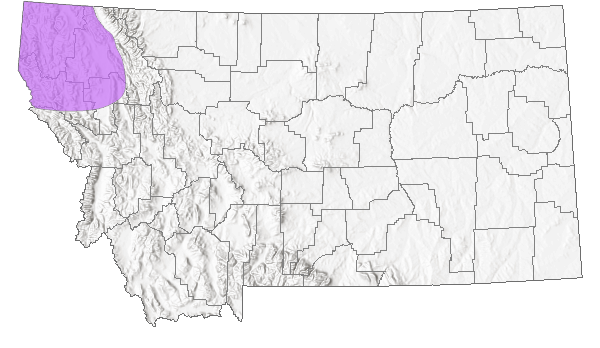
 Native
Native
Range Comments
BC s to CA, ID and MT; Mexico (Baja California) (FNA 2015).
Observations in Montana Natural Heritage Program Database
Number of Observations: 36
(Click on the following maps and charts to see full sized version)
Map Help and Descriptions
Relative Density
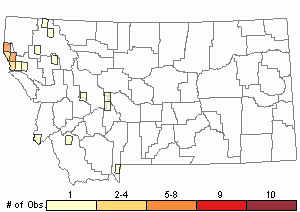
Recency
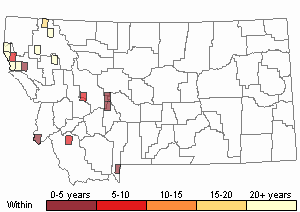
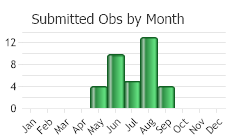
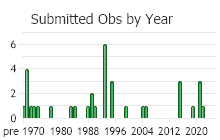
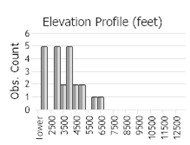 (Observations spanning multiple months or years are excluded from time charts)
(Observations spanning multiple months or years are excluded from time charts)
Habitat
Shrublands, disturbed places (FNA 2015), often on forest lands following burning or logging, prairies (Hitchcock et al. 1961), wet forests, often along roads, streams; valleys (Lesica 2012).
(Lesica’s contribution from
Lesica et al. 2012. Manual of Montana Vascular Plants. BRIT Press. Fort Worth, TX)
Ecology
POLLINATORS The following animal species have been reported as pollinators of this plant species or its genus where their geographic ranges overlap:
Bombus vagans,
Bombus auricomus,
Bombus bifarius,
Bombus borealis,
Bombus centralis,
Bombus melanopygus,
Bombus mixtus,
Bombus rufocinctus,
Bombus ternarius,
Bombus sitkensis,
Bombus occidentalis,
Bombus pensylvanicus,
Bombus bimaculatus,
Bombus griseocollis,
Bombus impatiens,
Bombus insularis,
Bombus bohemicus, and
Bombus flavidus (Heinrich 1976, Thorp et al. 1983, Mayer et al. 2000, Wilson et al. 2010, Colla and Dumesh 2010, Colla et al. 2011, Koch et al. 2012, Williams et al. 2014).
Reproductive Characteristics
Flowers: Flowers unisexual, in few-flowered cymes (terminal flowers opening first); calyx with long soft hairs, purple, stipitate-glandular; sepals narrowly lanceolate, 5–8 mm in length; petals white, 10–16 mm in length on staminate flowers; pistillate flowers with abortive anthers and oval petals 6–10 mm in length (Lesica 2012); ovaries smooth to hairy (FNA 2015).
Fruit: Fruit a cylindrical, red blackberry 2–3 cm in length (Lesica 2012) with 20-50 drupelets (FNA 2015).
Diocious (Hitchcock et al. 1961).
(Lesica’s contribution adapted from
Lesica et al. 2012. Manual of Montana Vascular Plants. BRIT Press. Fort Worth, TX)
Management
Can be difficult to remove from gardens (Hitchcock et al. 1961).
ECONOMIC VALUE
Fruit of the Pacific Blackberry is delectable, such that it is a progenitor of horticultural varieties, including Mammoth Berry, Loganberry, and Boysenberry (Hitchcock et al. 1961).
Stewardship Responsibility
References
- Literature Cited AboveLegend:
 View Online Publication
View Online Publication Colla, S., L. Richardson, and P. Williams. 2011. Bumble bees of the eastern United States. Washington, DC: USDA Forest Service, Pollinator Partnership. 103 p.
Colla, S., L. Richardson, and P. Williams. 2011. Bumble bees of the eastern United States. Washington, DC: USDA Forest Service, Pollinator Partnership. 103 p. Colla, S.R. and S. Dumesh. 2010. The bumble bees of southern Ontario: notes on natural history and distribution. Journal of the Entomological Society of Ontario 141:39-68.
Colla, S.R. and S. Dumesh. 2010. The bumble bees of southern Ontario: notes on natural history and distribution. Journal of the Entomological Society of Ontario 141:39-68. Flora of North America Editorial Committee, eds. (FNA). 2014. Flora of North America North of Mexico. Vol. 9. Magnoliophyta: Picramniaceae to Rosaceae. New York, NY: Oxford University Press, Inc. 752 pp.
Flora of North America Editorial Committee, eds. (FNA). 2014. Flora of North America North of Mexico. Vol. 9. Magnoliophyta: Picramniaceae to Rosaceae. New York, NY: Oxford University Press, Inc. 752 pp. Hitchcock, C. L., A. Cronquist, M. Ownbey, and J. W. Thompson. 1961. Vascular Plants of the Pacific Northwest, Part 3. Saxifragaceae to Ericaceae. Seattle, WA and London, England: University of Washington. 614 pp.
Hitchcock, C. L., A. Cronquist, M. Ownbey, and J. W. Thompson. 1961. Vascular Plants of the Pacific Northwest, Part 3. Saxifragaceae to Ericaceae. Seattle, WA and London, England: University of Washington. 614 pp. Koch, J., J. Strange, and P. Williams. 2012. Bumble bees of the western United States. Washington, DC: USDA Forest Service, Pollinator Partnership. 143 p.
Koch, J., J. Strange, and P. Williams. 2012. Bumble bees of the western United States. Washington, DC: USDA Forest Service, Pollinator Partnership. 143 p. Lesica, P., M.T. Lavin, and P.F. Stickney. 2012. Manual of Montana Vascular Plants. Fort Worth, TX: BRIT Press. viii + 771 p.
Lesica, P., M.T. Lavin, and P.F. Stickney. 2012. Manual of Montana Vascular Plants. Fort Worth, TX: BRIT Press. viii + 771 p. Mayer, D.F., E.R. Miliczky, B.F. Finnigan, and C.A. Johnson. 2000. The bee fauna (Hymenoptera: Apoidea) of southeastern Washington. Journal of the Entomological Society of British Columbia 97: 25-31.
Mayer, D.F., E.R. Miliczky, B.F. Finnigan, and C.A. Johnson. 2000. The bee fauna (Hymenoptera: Apoidea) of southeastern Washington. Journal of the Entomological Society of British Columbia 97: 25-31. Thorp, R.W., D.S. Horning, and L.L. Dunning. 1983. Bumble bees and cuckoo bumble bees of California (Hymenoptera: Apidae). Bulletin of the California Insect Survey 23:1-79.
Thorp, R.W., D.S. Horning, and L.L. Dunning. 1983. Bumble bees and cuckoo bumble bees of California (Hymenoptera: Apidae). Bulletin of the California Insect Survey 23:1-79. Williams, P., R. Thorp, L. Richardson, and S. Colla. 2014. Bumble Bees of North America. Princeton, NJ: Princeton University Press. 208 p.
Williams, P., R. Thorp, L. Richardson, and S. Colla. 2014. Bumble Bees of North America. Princeton, NJ: Princeton University Press. 208 p. Wilson, J.S., L.E. Wilson, L.D. Loftis, and T. Griswold. 2010. The montane bee fauna of north central Washington, USA, with floral associations. Western North American Naturalist 70(2): 198-207.
Wilson, J.S., L.E. Wilson, L.D. Loftis, and T. Griswold. 2010. The montane bee fauna of north central Washington, USA, with floral associations. Western North American Naturalist 70(2): 198-207.
- Additional ReferencesLegend:
 View Online Publication
View Online Publication
Do you know of a citation we're missing? Lesica, P., M.T. Lavin, and P.F. Stickney. 2022. Manual of Montana Vascular Plants, Second Edition. Fort Worth, TX: BRIT Press. viii + 779 p.
Lesica, P., M.T. Lavin, and P.F. Stickney. 2022. Manual of Montana Vascular Plants, Second Edition. Fort Worth, TX: BRIT Press. viii + 779 p.
- Web Search Engines for Articles on "Pacific Blackberry"





